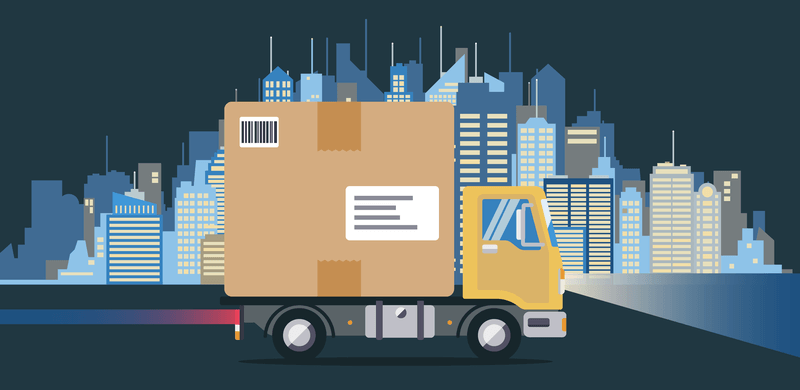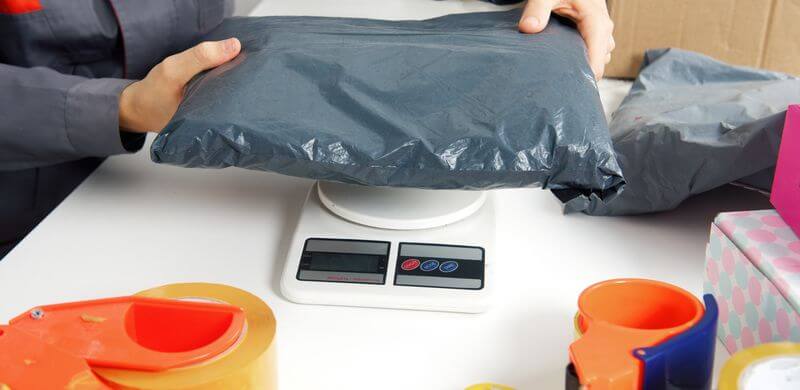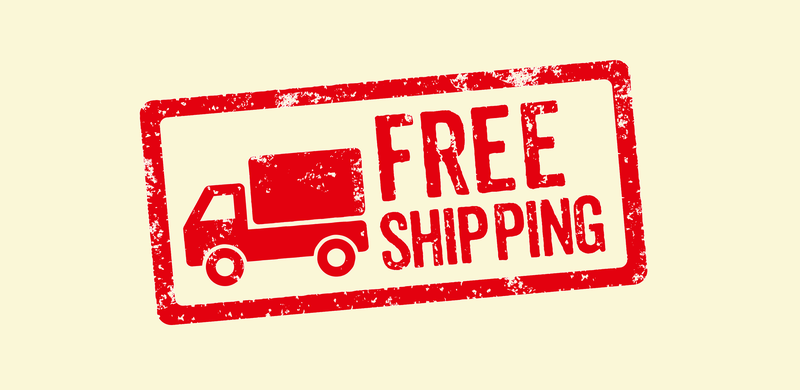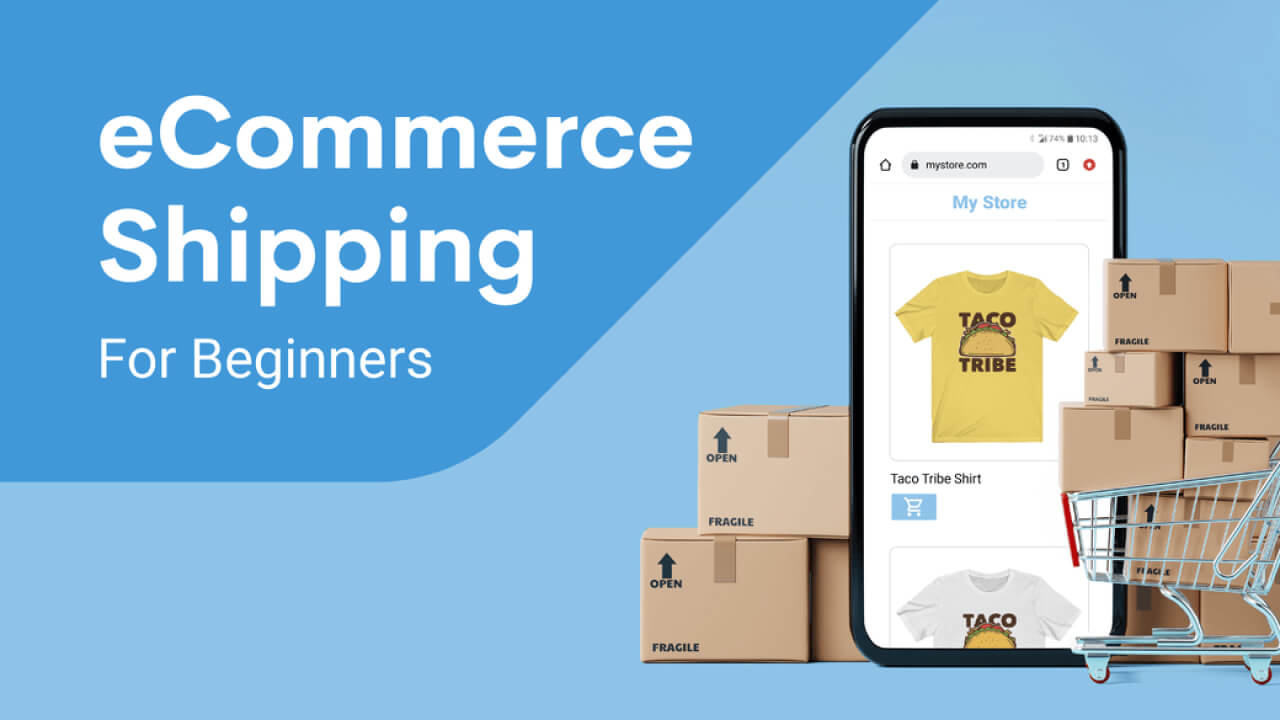Make a shirt with Printify today
Shipping may not be the most exciting part of eCommerce, but a sustainable shipping strategy can have a huge impact on the profitability of your online business.
In this article, we’ll quickly break down eCommerce shipping, how to find the right shipping method for your business, the impact shipping rates can have on conversions and how to accurately calculate shipping costs for your online store.
Harness the power of a sustainable shipping strategy to gain a competitive advantage and increase your profit margin!
What is eCommerce shipping?

eCommerce shipping is everything required to deliver goods purchased online to the end customer’s destination. It is a key part of eCommerce, as it’s the point where the customer finally experiences the product in person. It can represent a major expense, depending on your eCommerce shipping strategy.
eCommerce shipping is not just moving goods from A to B, it is a way to add value to the shopping experience and build trust with your customers. Your customers have to pay without physically seeing a product, so while you need to make your shipping affordable, the credibility of your store is dependent on ensuring delivery timeframes and package safety.
A successful eCommerce shipping strategy has a huge impact on customer experience. Check out these stats from research carried out in seven major eCommerce markets – UK, France, Germany, Spain, Netherlands, Italy and US:
- 54% of consumers say delivery defines who they shop with
- 39% will never shop with an online business again following a negative delivery experience
- 43% have used social media platforms to voice their displeasure at a poor delivery experience. Amongst 18-26-year-olds, this figure rises to 48%
This article will help you figure out every aspect of affordable shipping so that no question goes unanswered and your store launches with success.
Before we get into the essentials, check out a quick breakdown of these 5 terms that come up when looking at eCommerce shipping.
1. Shipping methods
These determine the shipping speed and who will deliver it. There are a range of common shipping services:
- Same-day Delivery
- Overnight Shipping
- 2-Day Shipping
- Longer Shipping Times
- International Shipping
2. Shipping rates
How much you charge your customer for shipping. This cost is on top of the cost of the goods they have purchased and are added to the order at checkout.
3. Shipping times
The timeframe between when order fulfillment is completed and the package is handed to the carrier, to when the order is delivered to the end customer.
4. Shipping cost
The variables that affect the price a carrier will charge to deliver your order. These factors include package measurements, shipment type, weight, speed, delivery preferences and location.
5. Shipping carrier
eCommerce shipping companies that deliver your products to the customer. The rate they charge will be based on a range of factors unique to every shipment.
6. Profit margins
Profit margin represents the percentage of each sale that has been turned into profit. For example, if a business achieved a 20% profit margin during 2021, they made a net income of $0.20 per dollar sold. It is one of the most common ratios used to gauge the profitability of a company or business activity.
Make it happen today!
Common eCommerce shipping options

A range of eCommerce shipping options are available, each with its own unique benefits. Check this quick breakdown of all the most common to find the right fit for your online business:
Same-day delivery
The demand for same-day delivery is huge. Research shows that over 75% of consumers prefer this shipping solution.
This shipping solution either delivers products to the customer on the same day the order is placed or ships out the product on the same day. Your eCommerce store should clearly state which version of same-day shipping you operate on, ensuring customers are completely aware of the shipping timeline.
Overnight shipping
Also known as next-day delivery, these services guarantee customers will receive their order the next business day. As with all rapid delivery services, demand is huge. Research shows that , next-day delivery makes 49% of shoppers more likely to shop online.
This is an excellent shipping option when a customer needs an order ASAP. Customers understand there is often an extra cost for overnight shipping, enabling you to pad your profit margin.
2-day shipping
Thanks to Amazon’s push for 2-day shipping as an industry standard, research now shows that only 44% of consumers are willing to wait two days for orders to be delivered via fast shipping.
Much like the previous two shipping solutions, this may not be the most cost-effective shipping solution until your eCommerce business has scaled to the point where you can afford the infrastructure necessary.
Longer shipping times
These are usually the most affordable eCommerce shipping methods available. Research indicates that only 15% of US consumers are happy about delivery speed and these slower methods, such as ground shipping, are best saved for items that are not time-sensitive.
While many people want to receive items quickly, many are willing to wait a few days. According to research, 21% of people are willing to wait 3-4 days and 10% will wait 5-7 days, however only 2% are willing to wait 1-2 weeks.
International
International shipping is any shipping method that transports and delivers packages beyond the online business’s domestic shipping area. This could be across different countries or even continents.
Understanding eCommerce shipping rates

Before you start shipping your eCommerce orders, you first need to set the rates you will charge your customer at checkout.
This can have a huge impact on your conversions, with one Paypal report indicating that 43% of consumers abandoned their carts because of high shipping charges.
All shipping couriers base rates on a variety of factors including:
- Package size
- Package weight
- Origin address
- Destination address
- Plus additional shipping options like tracking and international shipping insurance.
There are several common methods for setting exact shipping rates and it can be difficult to compare services exactly, as they all offer slightly different options.
Every online store has its own unique variables and your choice should always be based on the underlying financials of your business.
1. Flat-rate shipping
When you offer flat-rate shipping, customers get a set price for the shipping option, no matter the dimensions or weight of the order. Charging a flat rate for shipping allows your online shoppers to increase their orders without increasing the overall shipping cost, making large orders more attractive.
2. Real-time carrier rates
This shipping pricing method is to charge live carrier rates for delivery. Sales channels like Shopify have shipping integrations that work in real-time with a range of shipping carriers to generate shipping solutions and live pricing. This gives your customers the flexibility to pick and pay for the exact services they want.
3. Free shipping
Everyone loves something for nothing and free shipping is no exception!
This shipping rate is an eCommerce customer favorite and one of the best ways to reduce online shopping cart abandonment. However, remember shipping is never free and someone has to pay for it.
4. Expedited shipping
When customers need an order delivered ASAP, expedited shipping can save the day.
This rate puts the package ahead of slower solutions like flat-rate and in some cases provides definite delivery times. This shipping rate is often delivered in the same time frame as same-day, overnight, or 2-day shipping methods.
5. Local delivery
In a Shopify consumer trends report, one key trend is the increased support for small business owners. Nearly a third of consumers say they’ve bought something online and had it delivered locally during the first three months of the pandemic. 79% of those who reported shopping locally online said they did so to support their communities or protect local jobs.
Local delivery has the potential to connect with local customers, increase sales and be a memorable customer experience.
What’s the fastest and cheapest way to ship a t-shirt?

For everyone in eCommerce, delivery times can make or break your business.
Research has shown that since March 2020 and the start of the pandemic, consumers have increased their expected delivery timelines and are more likely to be willing to pay for fast shipping and care more about the delivery experience.
Despite the huge demand generated by Amazon’s two-day shipping promise, a study by the fulfillment platform Shipstation concludes that the average consumer was willing to wait five days between placing an order and delivery before the pandemic began, and this has now increased to 8 days.
When building your shipping process, look for the fastest and cheapest way to ship your product. Here are some quick tips:
Find a local dropshipping supplier or multiple suppliers
To get delivery times down, one of the most effective and simplest methods is to find a supplier that fulfills orders locally, shipping domestically.
When shipping print-on-demand products with Printify, you can select a print provider local to your customer. This will minimize shipping times and cut back on expenses. Not only is this great for your prices per order, but it will also have a positive impact on customer satisfaction.
Automating your order processing and fulfillment
Automating your order and fulfillment process means the whole process will be handled for you. The aim is that everything becomes a lot easier and a lot faster.
Tips to reduce eCommerce shipping costs
Here is a quick breakdown of the following tips and tricks to help you save on shipping expenses:
- Reduce package weight and dimensions
- Use flat-rate shipping when possible
- Offer local delivery or pickup
- Decrease the shipping distance
- Find discounted or free supplies
- Pick specific shipping and fulfillment center locations to maximize reach
- Research hybrid services
- Take advantage of cheaper rates for volume shipping
- Reuse boxes and packaging materials to reduce packaging costs
- Negotiate prices for business accounts
- Pick specific shipping and fulfillment center locations to maximize reach
Let us know in the comments which of these tips helped save you the most on shipping costs!
How to calculate shipping costs for your online store

eCommerce shipping services are essential for all online stores. Store owners need to make sure they are properly measuring the costs of shipping and they aren’t losing money when it comes to order fulfillment..
Each shipping courier bases shipping rates on a unique equation derived from a range of factors. It can be difficult to compare carrier services exactly, as they all offer slightly different options and every business will have its own unique variables.
Below you can find a breakdown of the shipping calculators with eCommerce shipping rates for some of the largest couriers. If you’re based in the US or Canada, you can pay for USPS, UPS, DHL Express, or Canada Post and receive pre-negotiated rates.
- USPS – Shipping Calculator
- Canada Post – Shipping Calculator
- UK Royal Mail – Shipping Calculator
- Australia Post – Shipping Calculator
- UPS – Shipping Calculator
- FedEx – Shipping Calculator
- Shopify – Shipping Calculator
Understanding how much shipping will cost enables you to select the best shipping strategy for your eCommerce store.
Consider your margins
It can be costly to live up to customer expectations, with fulfillment, delivery speed, and accuracy critical. This can lead to a struggle with eCommerce profitability.
Success in eCommerce requires you to always keep an eye on your profit margins. Before your pricing and strategy is set in stone, map out all the top eCommerce shipping solutions and cost of delivery.
Make it happen today!
Why you should offer free shipping

This offer can be crucial in boosting your sales and reducing cart abandonment. This study indicates that a lack of free shipping stops 68% of US online shoppers from making a purchase. These results heavily indicate that today’s online customers expect free shipping.
Cutting down on shipping costs is not optional and will enhance your conversion rates. A report by Statista shows that 63% of cart abandonment rates were caused by expensive shipping costs. Compounding this, in this study free shipping is shown to increase average order volume by a huge 97% .
Free shipping is the only website banner that matters from a conversion rate standpoint, according to this study. It also makes for a great messaging strategy that can be shared across other channels, including email and social media.
While free shipping can reduce abandoned shopping carts and increase sales, it could also negatively affect your profit margins. On the flip side, understanding how and where to invest in free shipping can increase your profits.
In this study, 93% of shoppers claim they will add items to their cart to qualify for free shipping.
To offset the costs of offering free shipping and make it sustainable, you can provide the following offers:
Minimum spend threshold
Setting a free shipping threshold can be a straightforward way to upsell and increase your average order value. However, an arbitrary threshold could be useless to customers or eat up your margins. For example, if your average order value is $20 and your minimum is $200, you won’t get many bites.
At the same time, if you set your minimum below your average order value, most customers will qualify and you will lose money. This quick breakdown will help you calculate your threshold. Breaking down your threshold can be essential to enable you to maintain a sustainable offer.
Bundles
If you can increase your average order value, then you can increase the affordability of offering free shipping. Bundles can be an easy method of offering a preselected group of products as one product, for example a gift set at a discount. Alternatively, you can offer a mix-and-match option for shoppers to save.
Nik Sharma, Founder of Sharma Brands, argues that, “Bundles are such a no-brainer. I don’t understand why more brands don’t utilize them. You’re not only optimizing shipping costs but getting more product into their household.”
Upselling through bundles can boost your average order value, while reducing average fulfillment costs.
eCommerce shipping for Printify integrations and API

Printify offers a global network of over 50 print providers and more than 500 unique products. Eact shipping rates vary depending on product type, print provider and delivery destination.
It is important to set up your store’s shipping in line with Printify’s shipping rates. Otherwise, you risk under or overcharging your customer.
Below you can find a quick breakdown of how to set up shipping rates with the main sales channels Printify currently integrates with.
1. Shopify
Shipping needs to be set up in one of the following ways:
If you have an Advanced/Annual Shopify plan or carrier-calculated rates available for your Shopify account, you can enable the Printify Shipping Calculator for Shopify.
If you have a basic or regular Shopify plan, you can choose between weight-based or price-based shipping settings.
2. WooCommerce
Download and activate the Printify for WooCommerce plugin. This will enable you to publish Printify products to your WooCommerce store, and the applicable shipping rate will be assigned to them automatically.
3. Etsy
The applicable shipping rates will be automatically assigned to Printify products.
4. eBay
The applicable shipping rates will be automatically assigned to Printify products. This handy how-to will give you a quick rundown of setting up shipping with eBay.
5. BigCommerce
Choose between “Free shipping” or weight-based flat rates. For more info, jump into this quick BigCommerce shipping guide.
6. Wix
Choose between “Free shipping” or a flat rate setup. Check out this quick breakdown of how to set up shipping with Wix.
7. PrestaShop
Choose between “Free shipping” or weight-based flat rates. For a detailed deconstruction, check out this Prestashop shipping setup guide.
8. Squarespace
Choose between “Free shipping”, flat rates, or weight-based flat rates. For an easy-to-digest guide, have a browse of this quick how to set up shipping with Squarespace article.
9. Custom Printify API
As integrating by API is highly case-specific, our specialist team is on hand to offer a bespoke service.
All sales channels have the standard shipping solution available. In addition, an priority shipping option is available in the following cases:
- Shopify stores (only if using the Printify Shipping Calculator)
- WooCommerce stores
- Manual orders submitted from your Printify account
For all other sales channels, existing orders can be upgraded for an additional charge if the chosen print provider offers it.
eCommerce shipping best practices

Delivery can make all the difference. You can have a great offering, but your shipping strategy can attract more customers, develop brand loyalty and increase customer satisfaction.
These best practices can help you use shipping to make sure your business grows:
1. Make shipping costs clear
49% of people abandon their shopping cart because extra costs at checkout were too high. This survey clearly shows that when consumers encounter unexpected shipping costs, they’re more likely to abandon their cart and not complete their order.
2. Display expected delivery times
Providing an estimated delivery date will save you a lot in customer support. If the customer can clearly see the delivery time before ordering a product, they will be aware of the minimum and a maximum number of days. This adds an extra layer of security and reliability for the customer.
3. Enable customers to track their package
Throughout the eCommerce shipping process, 97% of customers expect the ability to track the order. Providing customers with order tracking enables you to meet customer expectations and provide a higher level of customer service if there are shipping issues.
4. Provide a dood returns service
The quality of your returns service can offer you a competitive advantage. With 95% of consumers who are happy with a store’s return process state they’ll shop with the retailer again, a positive experience can benefit you in the long run. In this study, 49% of consumers actively check the retailer’s return policy before buying.
Summary
Shipping is a challenge for every eCommerce business and each store has its own unique combination of factors that influences its shipping strategy.
With this quick breakdown of eCommerce shipping solutions, you can pick a successful strategy that perfectly fits your online business, drive sales, save money and deliver customer satisfaction.
What is your favorite shipping service and why? Did we miss some eCommerce shipping solutions that should be on this list? Give us a shout in the comments below.












